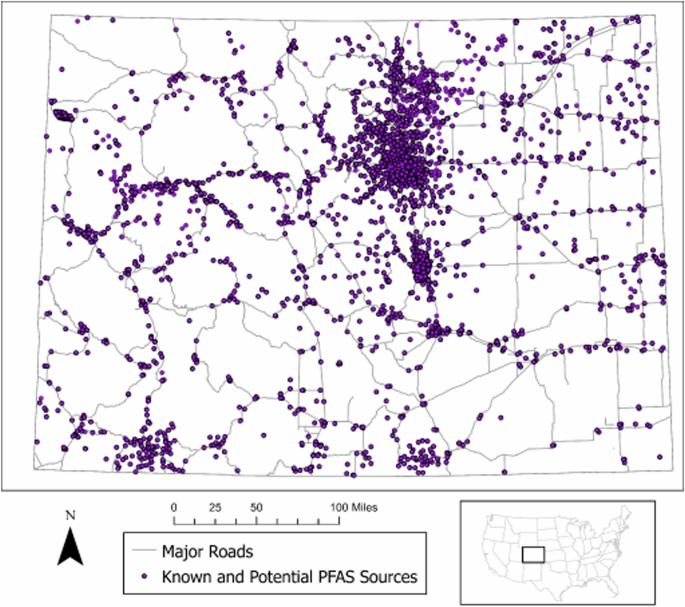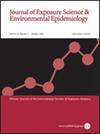A data-driven approach to identifying PFAS water sampling priorities in Colorado, United States
IF 4.7
3区 医学
Q2 ENVIRONMENTAL SCIENCES
Journal of Exposure Science and Environmental Epidemiology
Pub Date : 2024-08-01
DOI:10.1038/s41370-024-00705-7
引用次数: 0
Abstract
Per and polyfluoroalkyl substances (PFAS), a class of environmentally and biologically persistent chemicals, have been used across many industries since the middle of the 20th century. Some PFAS have been linked to adverse health effects. Our objective was to incorporate known and potential PFAS sources, physical characteristics of the environment, and existing PFAS water sampling results into a PFAS risk prediction map that may be used to develop a PFAS water sampling prioritization plan for the Colorado Department of Public Health and Environment (CDPHE). We used random forest classification to develop a predictive surface of potential groundwater contamination from two PFAS, perfluorooctane sulfonate (PFOS) and perfluorooctanoate (PFOA). The model predicted PFAS risk at locations without sampling data into one of three risk categories after being “trained” with existing PFAS water sampling data. We used prediction results, variable importance ranking, and population characteristics to develop recommendations for sampling prioritization. Sensitivity and precision ranged from 58% to 90% in the final models, depending on the risk category. The model and prioritization approach identified private wells in specific census blocks, as well as schools, mobile home parks, and public water systems that rely on groundwater as priority sampling locations. We also identified data gaps including areas of the state with limited sampling and potential source types that need further investigation. This work uses random forest classification to predict the risk of groundwater contamination from two per- and polyfluoroalkyl substances (PFAS) across the state of Colorado, United States. We developed the prediction model using data on known and potential PFAS sources and physical characteristics of the environment, and “trained” the model using existing PFAS water sampling results. This data-driven approach identifies opportunities for PFAS water sampling prioritization as well as information gaps that, if filled, could improve model predictions. This work provides decision-makers information to effectively use limited resources towards protection of populations most susceptible to the impacts of PFAS exposure.


在美国科罗拉多州采用数据驱动法确定全氟辛烷磺酸水质采样优先事项。
背景:全氟烷基和多氟烷基物质(PFAS)是一类具有环境和生物持久性的化学品,自 20 世纪中叶以来已在许多行业中使用。某些 PFAS 与不良健康影响有关:我们的目标是将已知和潜在的 PFAS 来源、环境的物理特征以及现有的 PFAS 水采样结果纳入 PFAS 风险预测图,该图可用于为科罗拉多州公共卫生与环境部 (CDPHE) 制定 PFAS 水采样优先级计划:方法:我们使用随机森林分类法建立了一个全氟辛烷磺酸 (PFOS) 和全氟辛酸 (PFOA) 这两种 PFAS 潜在地下水污染的预测面。该模型利用现有的全氟辛烷磺酸水样数据进行 "训练 "后,将没有采样数据的地点的全氟辛烷磺酸风险预测为三个风险类别之一。我们利用预测结果、变量重要性排序和人口特征来制定采样优先级建议:根据不同的风险类别,最终模型的灵敏度和精确度从 58% 到 90% 不等。该模型和优先排序方法确定了特定人口普查区块内的私人水井以及学校、移动房屋公园和依赖地下水的公共供水系统为优先采样地点。我们还确定了数据缺口,包括该州取样有限的地区和需要进一步调查的潜在来源类型:本研究采用随机森林分类法预测美国科罗拉多州两种全氟和多氟烷基物质 (PFAS) 污染地下水的风险。我们利用已知和潜在的 PFAS 来源数据以及环境的物理特征开发了预测模型,并利用现有的 PFAS 水采样结果对模型进行了 "训练"。这种以数据为导向的方法确定了 PFAS 水取样优先次序的机会以及信息缺口,如果填补了这些缺口,就能改进模型预测。这项工作为决策者提供了有效利用有限资源保护最易受 PFAS 暴露影响的人群的信息。
本文章由计算机程序翻译,如有差异,请以英文原文为准。
求助全文
约1分钟内获得全文
求助全文
来源期刊
CiteScore
8.90
自引率
6.70%
发文量
93
审稿时长
3 months
期刊介绍:
Journal of Exposure Science and Environmental Epidemiology (JESEE) aims to be the premier and authoritative source of information on advances in exposure science for professionals in a wide range of environmental and public health disciplines.
JESEE publishes original peer-reviewed research presenting significant advances in exposure science and exposure analysis, including development and application of the latest technologies for measuring exposures, and innovative computational approaches for translating novel data streams to characterize and predict exposures. The types of papers published in the research section of JESEE are original research articles, translation studies, and correspondence. Reported results should further understanding of the relationship between environmental exposure and human health, describe evaluated novel exposure science tools, or demonstrate potential of exposure science to enable decisions and actions that promote and protect human health.

 求助内容:
求助内容: 应助结果提醒方式:
应助结果提醒方式:


